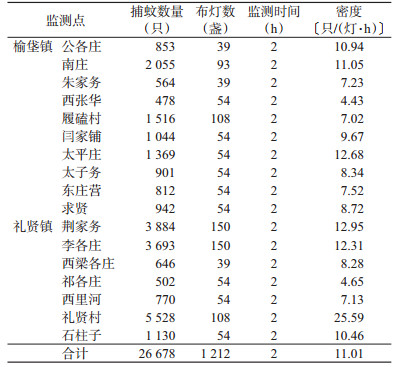扩展功能
文章信息
- 袁明, 高艳青, 王大川, 周小洁
- YUAN Ming, GAO Yan-qing, WANG Da-chuan, ZHOU Xiao-jie
- 北京大兴国际机场航站楼周边2014-2017年蚊媒监测结果分析
- An analysis of the surveillance results of mosquito vectors surrounding the terminal of Beijing Daxing International Airport, China, 2014-2017
- 中国媒介生物学及控制杂志, 2020, 31(1): 83-87
- Chin J Vector Biol & Control, 2020, 31(1): 83-87
- 10.11853/j.issn.1003.8280.2020.01.017
-
文章历史
- 收稿日期: 2019-09-11
- 网络出版时间: 2019-12-30 09:35
2 北京市疾病预防控制中心、北京市预防医学研究中心, 消毒与有害生物防制所, 北京 100013
2 Beijing Municipal Center for Disease Control and Prevention
北京大兴国际机场位于北京市大兴区与河北省廊坊市广阳区之间,是国家“十二五”规划确定的国家级重大基础设施项目,按2025年旅客吞吐量达7 200万人次、货邮吞吐量200万t、飞机起降量62万架次的总体目标设计。其航站楼面积70万m2,2014年破土动工,涉及拆迁13个村庄,近万亩农田耕作制度改变,同时天堂河京开路以东12.95 km改道。民居、农田、河流等原有自然环境被改变,对蚊媒种群数量势必将产生影响[1-3]。成蚊是多种媒介传染病发生纽带,如黄热病、登革热、流行性乙型脑炎等。为掌握该地区成蚊种类、密度及季节消长情况,大兴区疾病预防控制中心(CDC)自2014年5月开始在北京大兴国际机场航站楼建设核心地区周边开展蚊媒监测,为科学制定机场建设传染病防控保障方案提供数据支持,为建立该地区蚊媒本底档案积累翔实资料,为未来空港运行过程中防病保障工作的开展打下基础。
1 材料与方法 1.1 监测点概况北京大兴国际机场航站楼主体位于北京市大兴区礼贤镇和榆垡镇界内,面积约230 km2,永定河冲击平原,属暖温带半湿润大陆性季风气候,四季分明,年平均气温11.6 ℃,海拔37 m。常住人口8万多人,辖103个行政村,以农业种植为主(无水稻田)。
1.2 监测点设置2014年5月开始在大兴区榆垡和礼贤镇范围内,依据机场建设规划图接近航站楼一侧由东北向西南方向,116°21′49″~116°26′50″E,39°29′26″~39°33′25″N范围内,每镇随机选3个自然村,累计6个自然村,每村每次放3盏诱蚊灯(农户外环境)。监测过程中由于拆迁原因,监测范围固定,监测点每年有部分调整[4],随机选取新的监测点,补充因拆迁消失的监测点,每年监测点总数保持6个村不变,到2017年10月底2镇共监测17个自然村,其中12个村监测1年,3个村监测2年,2个村连续监测3年。
1.3 监测工具诱蚊灯(MT-1)及CO2诱蚊灯(军事医学科学院微生物流行病研究所与北京隆冠科技发展有限公司联合研制)、冷藏箱、显微镜。
1.4 监测方法CO2诱蚊灯法,依据GB/ T23797- 2009,每年5-10月每旬监测1次,每次连续监测2 h,晴天日落前1 h接通诱蚊灯电源,打开CO2气瓶,诱蚊灯悬挂离地1.5 m,远离光源,避风处悬挂。同时记录温度、湿度和风速。监测结束后将收集到的蚊虫放入冷藏箱带回分类,计数。形态学鉴定依据《中国重要医学昆虫分类与鉴别》[5]。遇雨天、风力4级以上监测工作顺延。
1.5 数据统计利用Excel 2003软件录入各监测点捕蚊数,汇总监测成蚊总数,计算蚊种构成比、季节变化等数据。
2 结果 2.1 蚊种构成及密度2014-2017年连续监测4年,共布灯69次,捕获成蚊26 687只,隶属库蚊属(Culex)、伊蚊属(Aedes)、阿蚊属(Armigeres)和按蚊属(Anopheles),共4属6种。其中优势蚊种为淡色库蚊(Cx. pipiens pallens,22 853只),构成比为85.63%,其次为骚扰阿蚊(Ar. subalbatus,2 800只),构成比为10.49%,白纹伊蚊(Ae. albopictus,813只)构成比为3.05%,背点伊蚊(Ae. dorsalis,132只)构成比为0.49%,三带喙库蚊(Cx. tritaeniorhynchus)、中华按蚊(An. sinensis)所占比例较小,另有44只残缺蚊虫不能鉴定。平均蚊密度为11.01只/(灯·h),各年蚊密度依次为12.26、7.11、15.24和9.75只/(灯·h),见表 1。

|
成蚊监测共17个村,以镇为单位,榆垡镇10个村,蚊密度为8.73只/(灯·h),礼贤镇7个村,蚊密度为13.26只/(灯·h)。以村为单位,成蚊密度最高为25.59只/(灯·h),最低为4.43只/(灯·h),不同村的蚊密度监测结果见表 2。

|
17个监测点4年共捕蚊6种26 687只,淡色库蚊构成比在所有监测点均最高。东庄营、荆家务、李各庄3个监测点捕获蚊种最多,见表 3。

|
2014-2017年平均蚊密度在6月下旬、7月下旬和9月上旬分别出现小高峰,后持续下降,见图 1。

|
| 图 1 2014-2017年北京大兴国际机场航站楼周边成蚊监测季节消长趋势 Figure 1 Seasonal fluctuations in adult mosquitoes around the terminal of Beijing Daxing International Airport, China, 2014-2017 |
| |
共捕获白纹伊蚊813只,占捕蚊总数的3.05%,位居蚊种构成比第3位,5月少量出现,8月达高峰。
3 讨论 3.1 成蚊种类构成及密度基本掌握了北京大兴国际机场周边成蚊种类、密度和季节消长情况,为蚊媒防制工作打下了基础。监测结果显示淡色库蚊为优势蚊种,与北京地区相关报道一致,但蚊种数量、构成比和密度均高于北京市2010-2012年监测结果[6]。本监测骚扰阿蚊构成比为10.49%,仅次于淡色库蚊,与有关报道存在较大差异[7],有待进一步调查。东庄营、荆家务、李各庄捕获蚊种最多,村边有天堂河经过,岸边杂草丛生,未经治理,适宜幼蚊的生长。北京大兴国际机场地处农村,农户居住周边环境复杂,有种植园、禽畜养殖场、积水坑等蚊虫孳生场所。灭蚊从治理环境开始。根据GB/T23797-2009[8]要求日落后开始监测,与白纹伊蚊、骚扰阿蚊活动规律发生矛盾,影响捕获数量。在今后的监测中,要全面考虑不利因素,增加不同的监测方法,以利于获得更全面的监测资料[9]。
3.2 不同区域蚊密度4年监测2镇17个自然村,礼贤镇蚊密度略高于榆垡镇。礼贤村蚊密度最高〔25.59只/(灯·h)〕,周边有农贸市场、养殖户、农田、积水等,环境复杂是造成蚊密度高的主要原因。榆垡镇西张华村蚊密度最低〔4.43只/(灯·h)〕,监测点前面是公路,后面是农田,无大的积水,与礼贤村的环境相比存在较大差异。本文监测地区与廊坊市接壤,4年平均蚊密度〔11.01只/(灯·h)〕高于廊坊区域蚊媒监测平均结果〔4.28只/(灯·h)〕[10]。蚊媒生活史的关键环节是水,因此降低蚊密度首先要治理水源,填埋积水坑、翻盆倒罐,减少蚊虫孳生地是关键。
3.3 季节变化蚊密度变化与温度、湿度有直接关系,5和10月最低,高峰出现在6月下旬,波浪式持续到9月上旬,之后下降。7、8月高温、高湿是蚊密度保持高峰的首要条件[11]。南方与北方相比蚊密度出现高峰有所差异[12-13],北方略晚。蚊密度高峰季节野外施工,施工单位要为职工提供合格的防蚊设施(宿舍安好纱门纱窗、蚊帐,配备驱蚊药等),旅游一定要做好个人防护,穿浅色长袖衣服,涂抹驱避剂等。
3.4 白纹伊蚊监测情况本监测白纹伊蚊捕获数量构成比为3.05%,位居第3,与有关报道相近[10],密度高峰在8月,有调查白纹伊蚊幼蚊密度7月出现高峰[14],提示降低伊蚊密度,灭蚊工作可在7月适时开展。伊蚊与登革热、黄热病、寨卡病毒病、裂谷热有密切关系。自2016年开始出现黄热病、寨卡病毒病、裂谷热输入性病例,加重了我国蚊媒病防控难度。北京大兴国际机场未来是重要的国际口岸,持续开展蚊媒监测,获得准确的本底资料,是非常重要的基础性工作。
3.5 建议病媒监测开展区域合作北京大兴国际机场整体位于北京市与河北省交界处,航站楼在北京地界,物流等配套设施位于河北省。未来机场运行过程中人流、物流都存在输入蚊虫及蚊媒病的风险,目前监测属于区域分散开展,不能全面掌握该地区蚊媒现状,建立完整的蚊媒档案资料,希望今后通过地区之间合作与交流来完善蚊媒监测内容,为未来鉴别输入蚊虫与本地所属提供依据,打破区域病媒监测是未来发展方向[15]。另外拆迁地区蚊媒现状是下一步工作目标,利用拆迁前后蚊媒资料的比较,进一步印证环境的改变对病媒生物种群的影响作用。
| [1] |
周正斌, 吕山, 张仪, 等. 上海市蚊媒种类、分布及其病原[J]. 中国媒介生物学及控制杂志, 2015, 26(1): 28-32. Zhou ZB, Lyu S, Zhang Y, et al. Mosquito species, distribution and their pathogens in Shanghai, China[J]. Chin J Vector Biol Control, 2015, 26(1): 28-32. DOI:10.11853/j.issn.1003.4692.2015.01.007 |
| [2] |
高强, 曹晖, 周毅彬, 等. 上海市中心城区成蚊种群动态及新变化研究[J]. 寄生虫与医学昆虫学报, 2014, 21(2): 110-116. Gao Q, Cao H, Zhou YB, et al. Mosquito population dynamics in Shanghai downtown[J]. Acta Parasitol Med Entomol Sin, 2014, 21(2): 110-116. DOI:10.3969/j.issn.1005-0507.2014.02.007 |
| [3] |
王剑, 姜进勇, 聂志坚, 等. 云南省南部人房蚊虫群落特征和季节消长分析[J]. 中国媒介生物学及控制杂志, 2017, 28(1): 42-45. Wang J, Jiang JY, Nie ZJ, et al. Investigations of indoor mosquito community characteristics and seasonal fluctuation in the southern area of Yunnan province[J]. Chin J Vector Biol Control, 2017, 28(1): 42-45. DOI:10.11853/j.issn.1003.8280.2017.01.012 |
| [4] |
余凤苹, 赵鑫, 张皓, 等. 三峡库区湖北省宜昌段2003-2015年自然疫源性疾病流行病学分析[J]. 中国媒介生物学及控制杂志, 2017, 28(1): 79-81. Yu FP, Zhao X, Zhang H, et al. Epidemiological analysis of natural focus diseases in Yichang of Hubei province in Three Gorges Reservoir during 2003-2015[J]. Chin J Vector Biol Control, 2017, 28(1): 79-81. DOI:10.11853/j.issn.1003.8280.2017.01.023 |
| [5] |
陆宝麟, 吴厚永. 中国重要医学昆虫分类与鉴别[M]. 郑州: 河南科学技术出版社, 2003: 1-67. Lu BL, Wu HY. Classification and identification of important medical insects of China[M]. Zhengzhou: Henan Science and Technology Publishing House, 2003: 1-67. |
| [6] |
张勇, 刘婷, 曾晓芃. 北京市2010-2012年蚊虫密度监测结果及变化趋势分析[J]. 中国媒介生物学及控制杂志, 2014, 25(2): 101-104. Zhang Y, Liu T, Zeng XP. Analysis of surveillance results and trends of mosquito density in Beijing from 2010 to 2012[J]. Chin J Vector Biol Control, 2014, 25(2): 101-104. DOI:10.11853/j.issn.1003.4692.2014.02.003 |
| [7] |
张曦, 赵新, 李岩, 等. 北京市天竺综合保税区2015年蚊媒监测结果与分析[J]. 中国媒介生物学及控制杂志, 2016, 27(5): 510-512, 519. Zhang X, Zhao X, Li Y, et al. Survey on mosquitoes at Beijing Tianzhu free trade zone in 2015[J]. Chin J Vector Biol Control, 2016, 27(5): 510-512, 519. DOI:10.11853/j.issn.1003.8280.2016.05.026 |
| [8] |
中华人民共和国国家质量监督检验检疫总局, 中国国家标准化管理委员会. GB/T23797-2009病媒生物密度监测方法蚊虫[S].北京: 中国标准出版社, 2009: 1. General Administration of Quality Supervision, Inspection and Quarantine of the People's Republic of China, Standardization Administration of China. GB/T 23797-2009 Surveillance methods for vector density-mosquito[S]. Beijing: China Standard Press, 2009: 1. |
| [9] |
韩雪玲, 张文香, 胡淑芳, 等. 安康市蚊虫种类调查[J]. 中国媒介生物学及控制杂志, 2014, 25(1): 70-71. Han XL, Zhang WX, Hu SF, et al. Survey of Culicidae (Diptera) species in Ankang city, China[J]. Chin J Vector Biol Control, 2014, 25(1): 70-71. DOI:10.11853/j.issn.1003.4692.2014.01.020 |
| [10] |
郝世宾, 夏宏伟, 赵琪, 等. 首都第二机场建设过程中廊坊市所属区域蚊类动态变化初步调查[J]. 中国媒介生物学及控制杂志, 2017, 28(6): 592-593, 599. Hao SB, Xia HW, Zhao Q, et al. Investigation on the dynamic change of mosquito fauna during the process of the second capital airport construction in Langfang, Hebei province[J]. Chin J Vector Biol Control, 2017, 28(6): 592-593, 599. DOI:10.11853/j.issn.1003.8280.2017.06.019 |
| [11] |
蒋峥, 何建邯, 周莉蓉, 等. 蚊密度与气温及降雨量关系的聚类分析[J]. 中华卫生杀虫药械, 2015, 21(2): 171-172, 174. Jiang Z, He JH, Zhou LR, et al. Cluster analysis on temperature, precipitation and mosquito density[J]. Chin J Hyg Insect Equip, 2015, 21(2): 171-172, 174. |
| [12] |
肖珊, 彭莱, 龙建勋, 等. 长沙市2007-2015年成蚊密度监测及趋势分析[J]. 中国媒介生物学及控制杂志, 2017, 28(1): 46-50. Xiao S, Peng L, Long JX, et al. The population density analysis of adult mosquitoes in Changsha city, China from 2007 to 2015[J]. Chin J Vector Biol Control, 2017, 28(1): 46-50. DOI:10.11853/j.issn.1003.8280.2017.01.013 |
| [13] |
高建荣, 刘金华, 刘戟环, 等. 近5年广州地区白纹伊蚊研究进展及防制对策[J]. 中国媒介生物学及控制杂志, 2014, 25(5): 483-485. Gao JR, Liu JH, Liu JH, et al. Research and control strategies for Aedes albopictus in Guangzhou, China, during recent five years[J]. Chin J Vector Biol Control, 2014, 25(5): 483-485. DOI:10.11853/j.issn.1003.4692.2014.05.030 |
| [14] |
刘洪霞, 朱江, 刘曜, 等. 上海地区2015-2016年白纹伊蚊幼虫监测及抗药性调查[J]. 中国媒介生物学及控制杂志, 2017, 28(4): 305-307, 331. Liu HX, Zhu J, Liu Y, et al. Study on the seasonal dynamics and insecticides resistance of Aedes albopictus larvae, in Shanghai, 2015-2016[J]. Chin J Vector Biol Control, 2017, 28(4): 305-307, 331. DOI:10.11853/j.issn.1003.8280.2017.04.001 |
| [15] |
霍新北, 刘起勇, 康殿民, 等. 重要病媒生物及相关传染病综合监测机制探讨[J]. 中国媒介生物学及控制杂志, 2012, 23(1): 7-9, 14. Huo XB, Liu QY, Kang DM, et al. Study of comprehensive monitoring mechanisms for critical vectors and related infectious diseases[J]. Chin J Vector Biol Control, 2012, 23(1): 7-9, 14. |
 2020, Vol. 31
2020, Vol. 31


